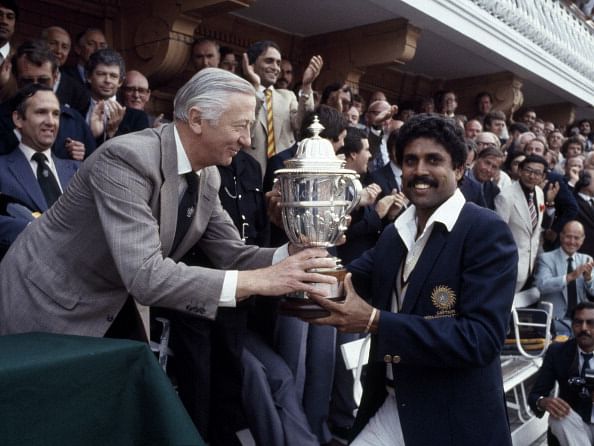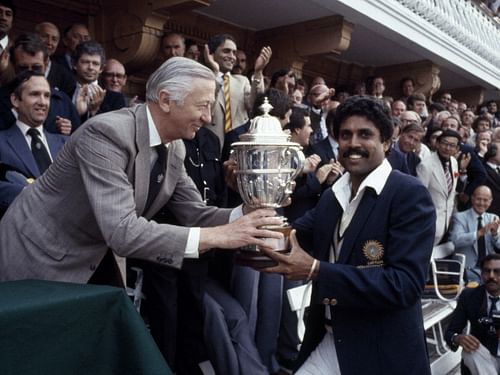
Kapil Dev - The irreplaceable warrior

It was 18 June 1983, and the scene was the Prudential World Cup. The skies at the Royal Tunbridge Wells were murky. Perhaps, it was the sign of an impending storm. When the Indian captain arrived at the crease at 9 for 4, the new ball bowlers for Zimbabwe were threatening to annihilate his batting line-up. Yet he walked back to the change room undefeated.
Ruthlessly destroying the same bowling attack with a merciless 175 (striking at 126.81), he single-handedly carried India to a respectable total. A week later, the enduring image of Kapil Dev Ramlal Nikhanj holding the World Cup trophy aloft at the famous Lord’s balcony is extensively believed to have changed Indian cricket forever.
An unforeseen joy
When he made his Test debut at Faisalabad on a featherbed of a pitch, the slip cordon comprising of the legendary Sunil Gavaskar and Gundappa Vishwanath found themselves chuckling at the sight of the Pakistan batsmen hopping around unable to fend off the bouncers that were rearing at their faces. They quickly realized that they had a fast bowler who could give something back to the opposition what they usually received.
Kapil went on to score the then fastest fifty by an Indian batsman in the same series, thereby proving that he could make a difference with the bat, too. Until his emergence, the new ball was largely seen as an abomination for the Indians. They opened the bowling with part-time medium pacers, impatiently waiting for the ball to lose its luster for the famous spin-quartet to grip the ball. But Kapil, with his flowing action, changed all that and went on to spearhead the Indian bowling attack for more than a decade.
A rare positive attitude
The most imperative contribution of Kapil was his aggressive line of thinking that he brought to the Indian team. He was the enforcer in all departments of the game that the country desperately needed. His approach was to win every game that he played. This was a stark contrast to the then prevailing mindset. Aside from Tiger Pataudi’s youthful exuberance, India rarely had a cricketer whose body language was to go for the kill.
Of course, this often did not endear him to the selectors, who felt that he was reckless. He defied team orders, which was to bat for a draw in a crucial Test match at Bombay, and was promptly dropped for the next match. He returned in the following Test on a typical Madras turner and smashed the first ball he faced over mid-off, thereby sending a signal to the dressing room, too. The crowd gave him a standing ovation. He was their hero.
The lion-hearted champion
He was and still is the finest athlete India have ever had. That he never missed a Test match due to injury was a testament to his immense fitness level. He was famous for the continuously long spells that he bowled on often unhelpful surfaces. In Melbourne 1980-81, Kapil overcame a groin injury to run through the Australian batting line-up to dismiss them for a paltry 83, thereby helping India win the Test match and thus draw a series for the first time in Australian soil with an uninterrupted spell of 5 for 28.
He also sent down another astonishing spell unchanged for over 30 overs, to finish with a 9 for 83 against the West Indies at home. His tireless exploits with the ball provided the fans with the only reason to cheer about in an otherwise abject performance by the team. His batting was absolutely destructive as he went on to demolish bowling attacks lower down the order.
His brutal assault on New Zealand in the 1980/81 Benson and Hedges World Series made Jeremy Coney wave a white handkerchief signaling his surrender to the great man. He also earned a tryst with the record books with a famous barrage of sixes off Eddie Hemmings at Lord’s to avoid the follow-on.
Final years and legacy
Kapil’s final years were constantly hampered by a wearing body, which was blighted by his untiring efforts over the years. Nevertheless, he was accurate with the ball, and his famously effective out-swinger was still intact. He counter-attacked with a rampaging century at Port Elizabeth against a South African bowling attack led by the frighteningly quick Allan Donald, proving that he still was a force with the bat.
His relentless pursuit of the record for the most Test wickets in a career drove him. Eventually, he overtook Richard Hadlee and finished as the most successful bowler in Tests with 434 scalps. He bowed out of cricket in a one-day match against West Indies, to complete his remarkable career with the most number of wickets in ODIs, as well (253 scalps).
The “Haryana Hurricane” is remembered amongst the greatest cricketers of all time. He deservedly was inducted into the ICC Hall of Fame. Wisden christened him as the “Indian Cricketer of the Century”. As we look back on India’s proud cricketing history, there is a debate about the greatest Indian cricketer of all time. Naturally, some would anoint Sachin Tendulkar or Sunil Gavaskar or even Anil Kumble.
An important criterion to conclude will be the lasting legacy. Replacing great batsmen has never really been an issue for the Indian team; the most pertinent problem, though, has been in unearthing the ‘next’ Kapil Dev. And they have not even come remotely close to it. Probably, they never will.